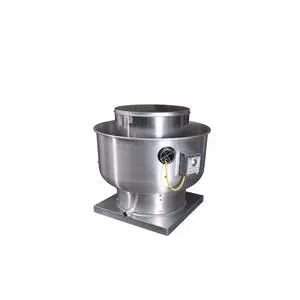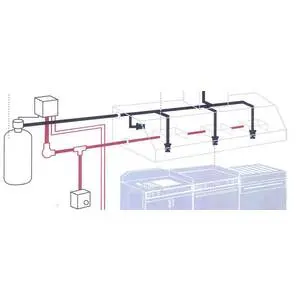Please note that this is a reference guide and should not be viewed as a substitute for National or Local Fire Code. Also you must have a Licensed HVAC or Mechanical Contractor do all of the installation and permitting.
A commercial restaurant kitchen, grease, exhaust, type-1, vent hood is essentially comprised of three main components: 1) the Shell of the Hood, 2) the Baffled, Grease Filters, and 3) the Trough at the bottom of the Filters. You have to then produce negative pressure or a vacuum to ensure that all of the heat, smoke, soot, and/or grease-ladened vapors are expelled from the facilities. An Upblast, Grease Fan that is on the exterior of the Facilities, accomplishes this. An additional Fan may be required as dictated by the amount of exhaust or by local code.

Sizing a Grease Hood and Heat / Condensate Hood
To determine the correct size Grease Range Hood System to install, National Fire Code (NFC) dictates that the Hood should be 6 inches larger on all sides compared to all of the equipment that is under it. Please consult your local Building Code Office to see if they require more overhang. For example, if you have a 36" wide, 6-eye Range, 24" Char Broiler, 36" Griddle, and two Gas Fryers (average 16" wide), you would add the total widths to come up with 128 inches.
With the additional 12 inches (may vary by local regulations) for the overhang of the Hood, this comes up to 140 inches or 11 feet, 8 inches. Rounding up to the nearest foot, you would therefore need a 12-foot Hood. You should also keep in mind what the future may dictate in terms of additional or larger items. You may outgrow a 24" Broiler and swap it out with a 36" or larger model and thus, would need the Hood to be larger. Also keep in mind that certain Code dictates certain spacing between items. Use this formula to also determine the size of Heat Hoods.
Sizing an Upblast or Exhaust Fan
The Hood Manufacturer dictates the Volume of Airflow (Cubic Feet per Minute or CFM) for their Hoods depending on the equipment under the Hood and whether the Hood is against a Wall or in the middle of the Room (Island Hood). The Manufacturer derives the airflow from parameters set out by National Fire Code (NFC). NFC dictates that, depending on the Cooking Equipment; the Volume of Airflow can vary depending on low, medium, high, or very high heat cooking. Essentially, 10 feet of open flame, wok cookers will need significantly more Exhaust than the standard equipment of a range, griddle, fryer, etc.
As an example we can use the previously mentioned set up referenced in the “Sizing a Hood” Section, the 12’ Hood with the equipment listed would need an average of 4000 CFM . View Upblast Exhaust Fans.
Determine If a Make-up Air or Supply Fan is Needed
Make-up Air (MUA) Fans blow air into the facilities to compensate (make-up) for the air being pulled out by the Exhaust Fan. For some it may be a Local Code issue as to whether you need a MUA Fan. For others, it may be a matter of convenience and/or efficiency.
The general size and rule of thumb for MUA is a 6’ Hood or larger or 2000 CFM or more of Exhaust flow. If your conditioned air, whether heated or cooled, is getting pulled out of your facilities at a rate of 2000 CFM or greater it will cost you allot more money in the long run than the initial cost of a MUA Fan. You could even find it rather hard to open the door or the door gets slammed shut by the large amount of negative pressure being produced by the exhaust fan. To ensure that all of the smoke, grease, or odors get pulled out of the kitchen, it is necessary to have a little negative pressure. The general rule of thumb is about 85% of exhaust. Therefore the proper MUA Fan for 4000 CFM of exhaust would be about 3400 CFM.

Fire Supression
ACityDiscount strongly recommends adding a fire suppression system not only to your new grease hood, but to heat hoods, too. If you are on the fence about fire supression systems take a look at the statistics from FEMA about restaurant fires
Note: To determine the size and components for Concession Trailer Hoods your hood must comply with the fire code in each state where you intend to do business.




